NYC Just Had Its Worst Year for Brush Fires this Decade
As brush fires continue to rage in the New York area, data shows that they’ve become more prevalent in recent years.

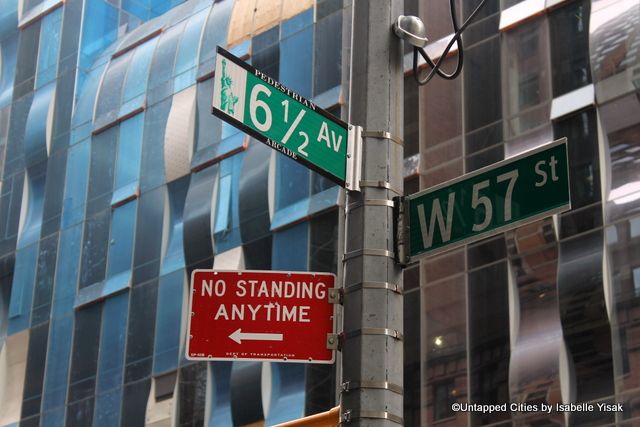
There are deviants among the orderly gridlines of Midtown Manhattan. They are not secret, but not so obvious either. You might have even passed by without knowing you could access them, or you may have passed through one thinking, defiantly, that you were trespassing. The arcades of Midtown connect one street to another through a building. They are the strange children of the ongoing public-private love affair dotted around New York City called POPS, privately owned public spaces. Zuccotti Park on Wall Street is perhaps the most famous example. These urban nesting dolls were built to provide the public with shortcuts, shelter and gathering spaces. Many are clustered amongst the dense buildings of Midtown.
There are three points of entry on 57th street: 889 Seventh Avenue, which is adjacent to Carnegie Hall, a fully enclosed arcade in shiny green and rust marble; the Metropolitan Tower at 46 West 57th Street, the most direct entry point and one that feels most like stepping into a brokers bachelor pad circa 1986 with its straight lines, polished black stone, electric blue accent lighting and string of built-in mini TVs; or Le Parker Méridien at 118 West 57th street, which is perhaps the most interesting.
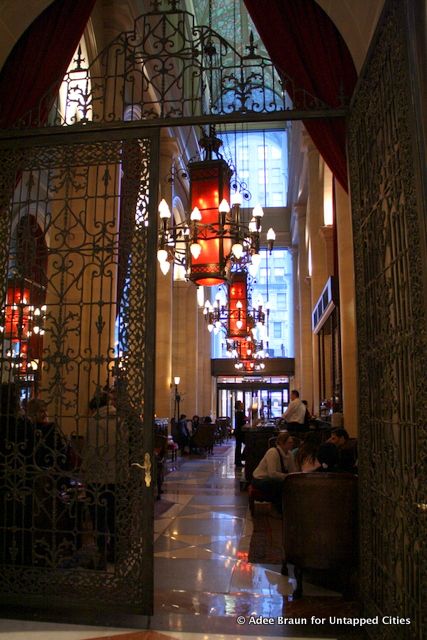
Sometimes owners don’t get the concept of public use, though. Since 1979 Le Parker Méridien has battled with the City over its elegant lobby, which is technically an arcade. The hotel is required to provide a certain number of tables and chairs for the public, which it has neglected to do over the years. But the thing you notice upon entering at 57th street is that half the lobby has been appropriated by The Knave, the hotel’s Gothic style cafe and bar that sells third-wave coffee and $5 mineral water. It’s actually quite beautiful and cozy. And, it’s actually in clear violation of POPS regulations.
In Privately Owned Public Space: The New York City Experience, Jerold S. Kayden claims that about half of the POPS are in some sort of violation. We asked one woman at the cafe if she knew she was sitting in a public space. “Well, it’s a hotel…” she answered. We explained the difference between a hotel lobby and a private space for public use. She seemed both moderately interested and moderately annoyed.
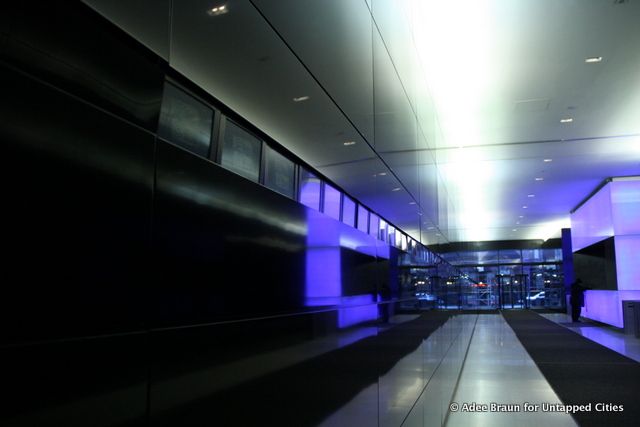
The arcade at 146 West 57th Street is another starting point for the 6 1/2 Avenue chain. It provides direct access through the block to 56th Street. The only problem is that it looks too much like a sleek 1980s lobby, which it is. The lobby of Metropolitan Tower has a security guard and doors at either end, making it practical for the cold and hot months, but rather unwelcoming.
As with the co-opted retail spaces of Le Parker Méridien and 1325 Sixth Avenue, this space acts overwhelmingly like a lobby, despite the signage that it is open to the public. If you frequently walk in and out of there on your way to work, you might get used to this. But if you are simply a pedestrian out of the know, you might feel like an uninvited guest.
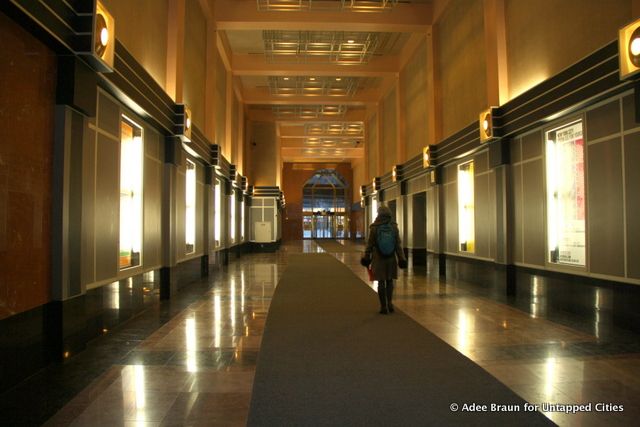
The arcade at City Spire Condos, 156 West 56th Street, connects 55th and 56th streets. The arcade is a little desolate and uninspired, but functional. The ’80s Art Deco design and walls lined with theater posters bring some interest into the space. It’s fully enclosed and climate controlled, making it one of the more luxurious POPS. The downside is that it’s dark, which we suspect is why it doesn’t seem to be used that much.
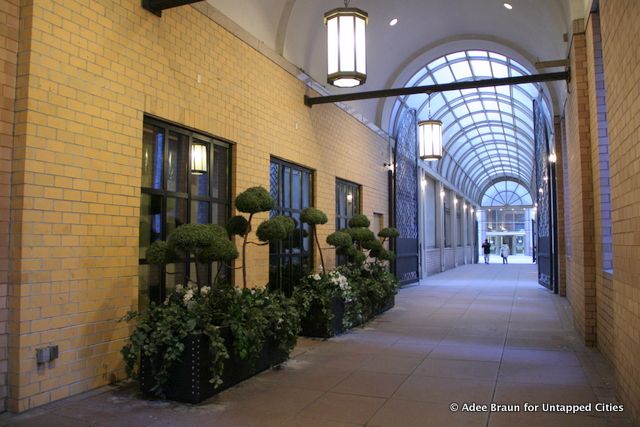
Like City Spire, this arcade at 151 West 54th street which connects 54th and 55th streets, is designed purely for moving pedestrians from one street to another. There are no benches for lingering, which is fine because although it is a covered arcade, it is otherwise exposed to the elements. The arcade abuts the London Hotel at one end and is enclosed with gates on both sides. Because the space is so open and there are friendly topiaries by the hotel side, it’s a pleasant walk especially on a sunny day when the light pours through the glass roof. So pleasant, in fact, that a homeless man had settled in by one of the planters where he sat smoking a cigar.
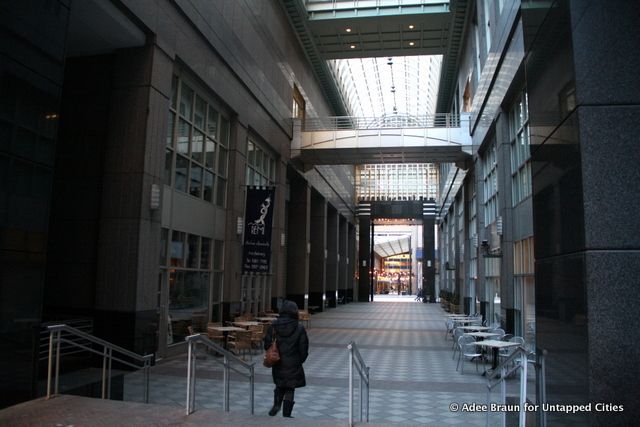
This open-air arcade at 1325 Sixth Avenue links 53rd and 54th streets. With ample tables and chairs, the arcade is a popular destination for an outdoor Midtown lunch in the warmer months, but it’s rather vacant in the winter. The soaring three-story-tall glass roof provides shelter and light, and the generous width of the space makes it feel more open and inviting than the narrower arcades. However, Kayden notes that on one visit, the cafes and restaurants had spread out their chairs and tables a little too widely, cluttering up the passageway for pedestrians. Yet another example of the co-habitational tensions between the private and public claims on POPS.
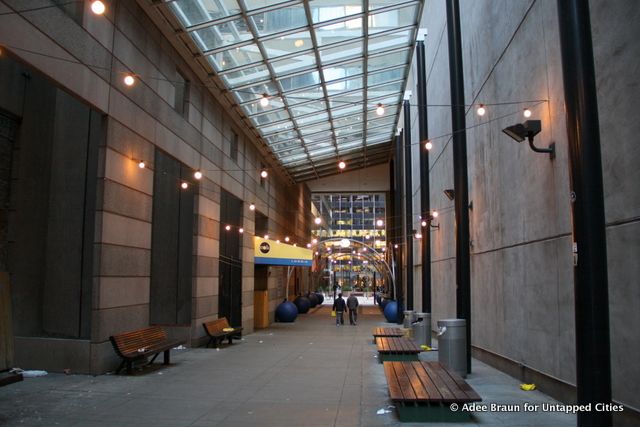
On the day we visited 135 West 52nd street, the arcade that links 53rd and 52nd streets, it looked as if the trash cans had had a food fight. Most of the arcades are tidy, so this was a surprise. The arcade is lined with otherwise inviting benches and is enclosed by gates, which Kayden cites were locked on one of his visits during supposed open hours. The relative enclosure of the space and all the litter makes it rather uninviting. Though with some sweeping and warmer weather, it’s possible to imagine the benches being used. Even so, this is a quick resting place rather than a meeting or lingering spot. The benches along this narrow passage give the feeling of a corridor or waiting room. But a clean place to sit is always welcome in the big city.
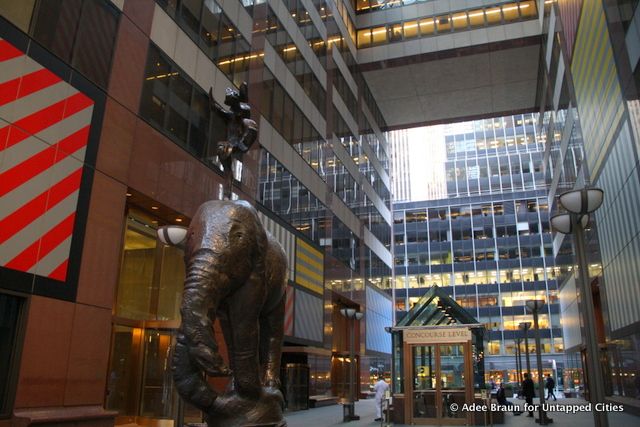
The end (or the beginning) of 6 1/2 Avenue brings you to the arcade of the AXA Building at 787 Seventh Avenue, between 51st and 52nd streets. This arcade connects two streets while also inviting people to look around or sit down. Barry Flanagan’s sculpture “Young Elephant” is the bonze centerpiece of this dynamic space. The colorful walls with stacked and jutting layers of windows makes you want to walk through and examine the arcade at all angles. Lunching on one of the solid stone benches inside this geometric space feels a bit like sitting inside a Rubik’s Cube. In a good way. And because it is so open with are no obstructing tables, people walk through at all hours, making it a prime people-watching spot.
More Midtown arcades
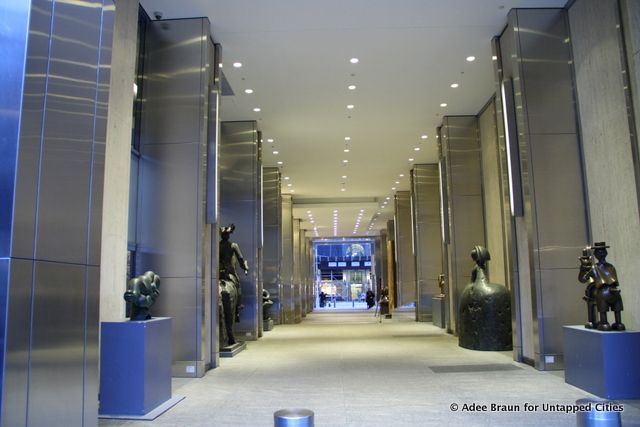
Though not part of the 6 ½ Avenue stretch, this arcade by the Marlborough Gallery provides a direct passage between 57th and 56th streets between Fifth and Sixth Avenues. Kayden calls it the “‘Model-T’ of through block arcades” because it exists with the simple purpose of bringing pedestrians from one street through another. And, it does so in a bright and inviting way. It is fully covered, yet door-less, brightly lit, clean and clearly meant to be walked through. It is utilitarian in that it has no benches, but is is also welcoming with whimsical sculptures lining the walls by the likes of Tom Otterness, Fernando Botero, Manolo Valdes, Jacques Lipchitz to name just a few.
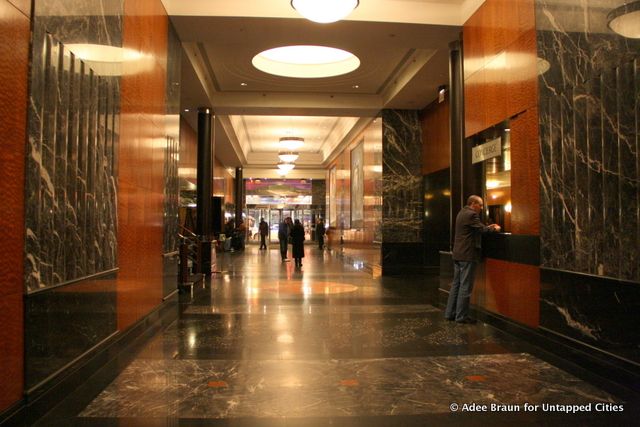
The Millennium Broadway Hotel at 145 West 44th Street is another hotel-lobby that is a POPS in disguise. Though not as hidden as Le Parker Méridien’s lobby, it is not obvious that the Millennium’s lobby is a public arcade. It has disappeared behind velvet seating areas and marble concierge desks. It just looks too nice to be public.
Arcades like the ones at the Millennium Broadway and Le Parker Méridien are near-secret spaces used by those in the know or with sharp enough eyesight to notice the “Public Space” sign. As Kayden notes: “the positive side of this private-public merger is that there is no stinting on quality…The negative side is that the very identity of the space as public disappears.” While it’s fun to be on the inside of such a secret, it defeats the purpose of POPS. The fundamental problem with POPS lies in its very nature. Private owners want to use their property the way they want to, which is often in conflict with the way the public would like them to.
The effectiveness of the Midtown arcades is a balancing act. The space cannot be too enclosed and unwelcoming, or too open and misused. The most successful arcades are the plaza-like ones that don’t need signage to convey they are public. The balancing act is especially precarious because unlike the classic pedestrian arcades of Europe which are lined with shop windows that act as eyes and ears, the arcades of Midtown are artificial constructs. While the arcades are practical as congestion-alleviators and time savers, more care needs to be taken to make them consistently inviting. These arcades were born out of a mid-80’s private-public love affair. But, when an affair ends, it’s always the kids that suffer.
Subscribe to our newsletter